Full Contact Karate at the Aikido Sangenkai? Not really, but many of the quotations in this article originally appeared in the January 1996 issue of the Japanese magazine “Full Contact Karate” (フル・コンタクト・カラテ), in an article entitled “Secret Technique: The Secret of Aiki” (秘技・合気の秘密). They present an interesting survey of comments on Aiki from some of the leading exponents of both Aikido and Daito-ryu.
You may also be interested in Sagawa-den Daito-ryu Aiki-Budo instructor Masaru Takahashi’s technical essay’s on the nature of Aiki “What is Aiki?” (Part 1 | Part 2 | Part 3).
Survey says – this is Aiki!
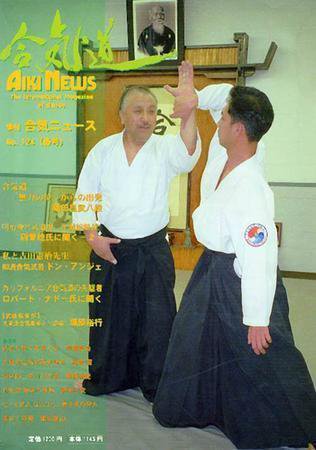 Masatake Fujita on the cover of Aiki News #124, April 20th 2000
Masatake Fujita on the cover of Aiki News #124, April 20th 2000
Masatake Fujita (藤田 昌武) – Aikikai Hombu Dojo
(student of Morihei Ueshiba)
合気会は合気道を国内外に推進・普及している中心団体として活動していますが、合気という言葉自体を特別に取り上げ定義・説明はしていません。合気道は競技体系を持っていませんので、約束稽古・型稽古を通じて体の鍛練をすると同時に、相手と合い和する心の鍛錬を目的にしています。そして、こうした稽古を通じて、誰もが持っている合気も養われ、発揮されてゆくと考えています。
The Aikikai is the central organization promoting and spreading Aikido domestically and abroad, but it has not adopted a particular definition or explanation of the word “Aiki” itself. Since Aikido has no form of competition, it seeks to train the spirit of harmony with the partner while conditioning the body through “Yakusoko-geiko” and “Kata-geiko”. Through this practice we believe that anyone’s Aiki can be developed and manifested.
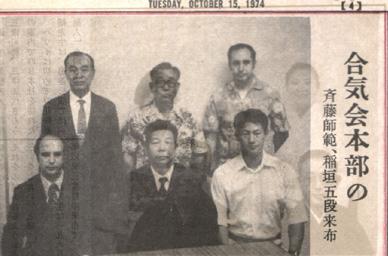 Photo from the Hawaii Hochi, 1974, announcing
Photo from the Hawaii Hochi, 1974, announcing
Morihiro Saito’s one day seminar at the Honolulu Aiki Dojo
on his way back from California to Japan.
In front: David Alexander, Morihiro Saito and Shigemi Inagaki
Morihiro Saito (斉藤 守弘) – Aikido Ibaragi Dojo
(student of Morihei Ueshiba)
合気道はそもそも植芝盛平先生から伝わったもので、先生から伝えられた合気を、現在正しく伝えているのはうちしかない。今の多くの合気道家は、合気を求めるあまり、先生の伝えた稽古を疎かにしている。それでは合気を得ることは出来ない。合気は本来誰もが持っているものだが、それは正しい型の稽古から発揮されるもので、その為には、正しい型の稽古を繰り返すことにより習得しなければならず、それなくして合気を得ることはない。
From the beginning Aikido was passed down from Ueshiba Morihei sensei, but today we are the only ones who are correctly transmitting the Aiki received from Sensei. In their quest for Aiki most Aikido students today are neglecting the training passed down from Sensei. So, they are unable to grasp Aiki. Aiki is fundamentally something that is possessed by everybody, but it is manifested through correct Kata practice. If one does not learn through the repetition of correct Kata practice then they will never grasp Aiki.
 Hitoshi Nakano – Nakano Orthopedic Clinic (なかの整骨院)
Hitoshi Nakano – Nakano Orthopedic Clinic (なかの整骨院)
Hitoshi Nakano (中野 仁) – Yoshinkan Hombu Dojo
(student of Gozo Shioda)
合気を得るには、理屈によるものと体によるものがあります。どちらも合気という答えを求めているのですが、戦後の新しい流派の多くは、過程を飛ばして理屈により答えを求めているようです。私達はそれとは違い、基本動作や指導稽古等の過程、体を使った稽古を通じて合気を習得する方法をとっています。また、合気は必ずしも神秘的なものではなく、敵との間合いや殺気を感じる等のことを含めて合気であると思います。
In order to grasp Aiki there are those that approach through theory and those that approach through the body. Both of these seek the answer to Aiki, but most of the new schools from the post-war skip past the process and seek the answer through theory. We are different from that, we chose the method of learning Aiki though the process of such things as Kihon-dosa and guided practice, training that uses the body. Further, Aiki is not necessarily mysterious, I believe that Aiki also includes such things as the Ma-ai with the enemy and sensing their murderous intent.
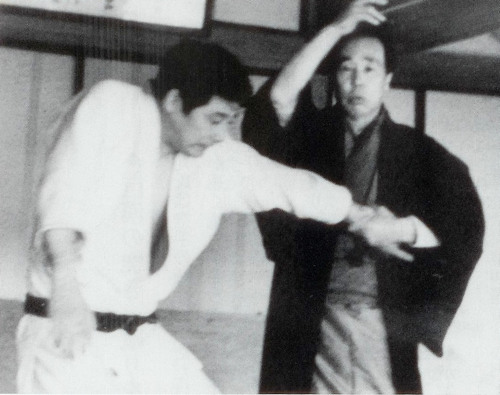 Keisetsu Yoshimaru taking ukemi for Yukiyoshi Sagawa, 1972
Keisetsu Yoshimaru taking ukemi for Yukiyoshi Sagawa, 1972
Keisetsu Yoshimaru (吉丸 慶雪) – Aiki Rentai Kai
(student of Yukiyoshi Sagawa)
合気というものは伸筋を使い相手を崩す「技術」で、その原理は全て合理的に説明が出来ます。そして多くの人が気と呼んでいるものは、この伸筋の力を指しているもので、神秘的な意味での「気の力」は存在しません。ただ、この伸筋の働きは、使っている人が「力を使っている」という意識が出来ないため、多くの人はこれを指して「気の力」と呼んでいるわけです。ですから合気と気は分けて考える必要があるのです。
Aiki is a technique that uses the extensor muscles to destabilize the opponent, the principles can all be explained rationally. Since what many people call “Ki” actually refers to the power of those extensor muscles there is is no such thing as a mysterious “Ki Power”. However, since the person making use of the movement of these extensor muscles has no consciousness of “I am using power”, many people refer to this as “Ki Power”. For that reason, Aiki and Ki must be thought of separately.
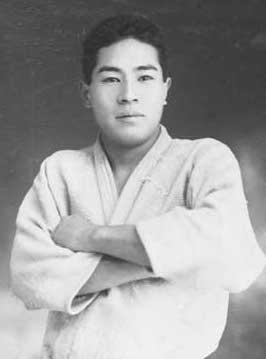 Minoru Mochizuki – around 1930
Minoru Mochizuki – around 1930
Minoru Mochizuki (望月 稔) – Yoseikan Aiki-Budo
(student of Morihei Ueshiba)
合気の気は「やる気」。すなわち闘志です。闘志と闘志のぶつかり合い。それが合気道だと思います。気には強いものもあれば弱いものもある。しかし、それらは修練によって強くなるものです。私のところにも女か男かわからのいような若者が入門してきますが、稽古が進むにつれて、道場での態度も引き締まってくる。つまり、やる気が出てくる。やる気のある者は、より積極的に稽古に取り組むようになる。それが大切なのです。
The Ki of Aiki is “Yaru-ki” (“the spirit of commitment”). In other words, “fighting spirit”. The collision of fighting spirit with fighting spirit. I believe that this is Aikido. If there is someone who is strong in Ki then there is also someone who is weak. However, that is something that becomes strong through training. We have both young men and women enter my place, but as they continue to practice their bearing becomes firm. In other words, they develop “Yaru-ki”. Those with Yaru-ki begin to tackle their training even more aggressively. That is important.
 Yusuke Inoue at the 50th Anniversary of Sokaku Takeda’s Passing
Yusuke Inoue at the 50th Anniversary of Sokaku Takeda’s Passing
Yusuke Inoue (井上 祐助) – Daito-ryu Aiki-jujutsu Kodokai
(student of Kodo Horikawa)
言葉や文章ではなく、実技を通じて伝えてゆくべきものであるだけに、定義したり、本に書いたりしたこともありません。人それぞれの個性というものがあるように、修業の過程でその者の個性ないし特徴を見ながら、「それを伸ばしてやるにはどうすればよいのか」という部分に重点を置いて教えています。その結果、私と違った合気を身につけたとしても構わないと思います。それがその人の持ち味なのですから。
It is something that should only be transmitted through actual techniques, not through words or writing, I have never defined it or written a book about it. Just as everybody has their own character, while watching those people’s character or characteristics I teach them while placing emphasis on certain sections – “what should you do in order to extend that?”. I believe that the result, that they may acquire an Aiki that is different than mine, is acceptable. Because that is each person’s inherent flavor.
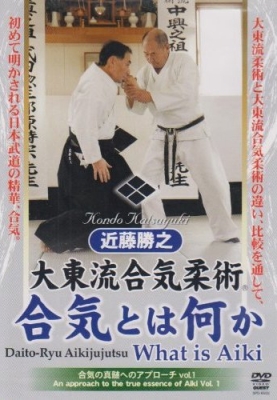 Katsuyuki Kondo’s DVD “What is Aiki”
Katsuyuki Kondo’s DVD “What is Aiki”
Katsuyuki Kondo (近藤 勝之) – Daito-ryu Aiki-jujutsu
(student of Tokimune Takeda)
大東流の技は5つの基本(礼儀、目付、呼吸、間合、残心)を修得し、合気による崩しが加わることで完成します。柔術の崩しと合気による崩しは異なるので、必ずしも合気=崩しではありませんが、最初の段階では「崩し」と理解してよいでしょう。相手の虚をついて崩すこともありますが、合気による崩しは相手が触れた瞬間に崩していなければなりません。そのためにも、基本の修得が必要不可欠となるのです。
Learn the five fundamentals of Daito-ryu (reiho / etiquette, metsuke / use of the eyes, kokyu / breath, maai / distance, zanshin / awareness), and perfect them through the addition of destabilization by Aiki. Since the destabilization accomplished through Aiki is different from the destabilization of jujutsu, Aiki is not necessarily equivalent to destabilization, but at the beginning level it is acceptable to conceive of it as “destabilization”. There are instances in which one destabilizes the opponent when they are unaware, but destabilization through Aiki must destabilize the opponent in the instant in which they touch you. Also for that reason, learning the fundamentals are absolutely necessary.
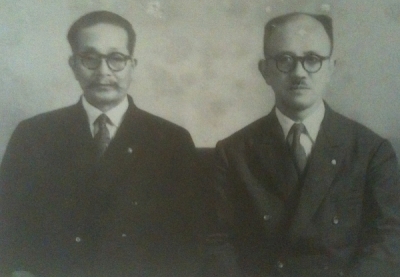 Takeshi Maeda (right) with his teacher Toshimi Matsuda
Takeshi Maeda (right) with his teacher Toshimi Matsuda
Takeshi Maeda (前田 武) – Daito-ryu Aiki-jujutsu Renshinkan
(student of Toshimi Matsuda)
「集中力」ではなく、触れることで相手を無抵抗にさせることだと思います。接点から気を出して、丹田から足へと伝えることによって相手を動けない状態にしてしまう。あとは投げようが倒そうが、こちらの意のままです。師匠の松田敏美には「力を入れるな」と教わりました。師の手を握った時の感触を覚えておいて、あとは自分でいろいろ思考錯誤することで身に付くはずです。私の場合には30年ぐらい掛かりましたね。
It is not “Shuchu-ryoku” (“focused power”), I believe that it is to make the opponent non-resistant upon touch. Extend Ki through the contact point, transmit from the Tanden to the feet and put the opponent in a condition in which they are unable to move. After that, they may be thrown or taken down at will. I was taught by my teacher Toshimi Matsuda “Don’t put in power!”. One must remember the feel of taking the teacher’s hand and then absorb it through their own process of trial and error. In my case it took about thirty years.
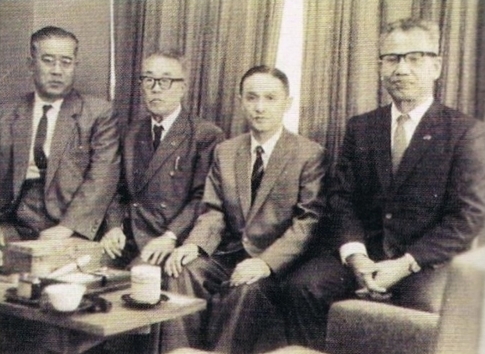 Gozo Shioda with Kodo Horikawa of the Daito-ryu Aiki-jujutsu Kodokai
Gozo Shioda with Kodo Horikawa of the Daito-ryu Aiki-jujutsu Kodokai
Gozo Shioda (塩田 剛三) – Yoshinkan Aikido
(student of Morihei Ueshiba)
こうしてやろう、ああしてやろうという欲を棄てなければなりません。頭で判断して動くのではなく、五感の反応にまかせてしまったとき、初めて自由にさばくことができます。そうなったらもう、相手の攻撃の種類などは問題外になるのです。
You must rid yourself of the desire to do this at this time, or to do that at that time. One does not move through an intellectual decision. Only when you leave it to the five senses is one able, for the first time, to move freely.
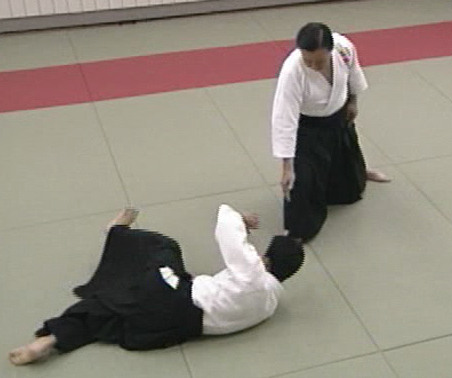 Hakaru Mori at the 50th Anniversary of Sokaku Takeda’s Passing
Hakaru Mori at the 50th Anniversary of Sokaku Takeda’s Passing
Hakaru Mori (森 恕) – Daito-ryu Aiki-jujutsu Takumakai
(student of Takuma Hisa)
合気をかけ、合気技を行なうためには、関節技で要求されるこのような力・技術・要領等は必要要件ではない。むしろ、邪魔になると言ってもよい。
In order to apply Aiki and execute Aiki techniques, the strength, technical points and other essentials required for joint techniques are not necessary requirements. You could even say that they are an impediment.
つまり、合気技と関節技は、技の原理が全く異なっており、極端に言えば、両者の術理は対極にあると言ってもよい。従って、関節技の稽古をどれ程重ねても、それだけでは絶対に合気には到達できないのである。
In other words, the fundamental principles behind Aiki techniques and joint techniques are completely different, stated extremely one could even say that their technical principles are diametrically opposed. Accordingly, however much one trains in joint techniques, that alone will absolutely not enable one to accomplish Aiki techniques.
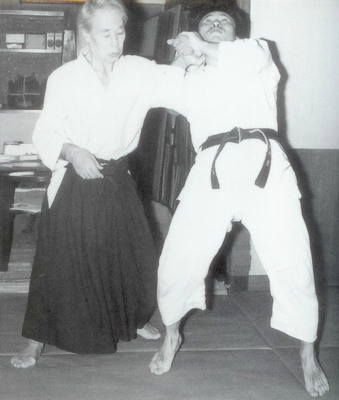 Yukiyoshi Sagawa demonstrates Morote-Dori Aiki-Nage
Yukiyoshi Sagawa demonstrates Morote-Dori Aiki-Nage
Yukiyoshi Sagawa (佐川 幸義) – Sagawa-den Daito-ryu Aiki-Budo
(student of Sokaku Takeda)
柔術を形としてやるのが一番悪い。実際に全然使い物にならなくなってしまう。変化が大事なのだ。私の所のやり方はそうだ。一つの代表として形を教えても臨機応変に変化する。
Doing jujutsu as Kata is the worst. It will become something that you can’t use at all in reality. Change is important. The way of doing it in my place is like that. Even if we teach a single representative Kata, we change flexibly.
結局のところ(諸々の技は)合気之体を作ることが目的であって、合気之体ができればどのように動いても技になり合気になる。
Ultimately, the goal (of my technique) is to create the Aiki body, if one can create the Aiki body than however they move it becomes a technique, becomes Aiki.
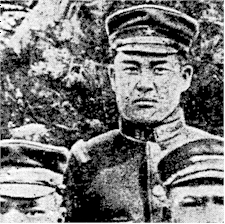 Morihei Ueshiba in uniform during the Russo-Japanese War
Morihei Ueshiba in uniform during the Russo-Japanese War
Morihei Ueshiba (植芝 盛平) – Aikido
(student of Sokaku Takeda)
動けば技が生まれる。
When I move technique is born.
この道は、天の浮橋に最初に立たなければならないのです。天の浮橋に立たねば合気は出て来ないのです。
In the Way, you must first stand on the Floating Bridge of Heaven. If you do not stand on the Floating Bridge of Heaven then Aiki will not come forth.
この合気も、また天の浮橋に立ちまして、そこから、ものが生まれてくる。これを武産合気といいます。
This Aiki stands on the Floating Bridge of Heaven, from there something is born. It is called Take Musu Aiki.
The Floating Bridge of Heaven (天の浮橋)
The phrase “Floating Bridge of Heaven” appears in O-Sensei’s lectures to the Byakko Shinkokai collected in the text “Take Musu Aiki” more than any other phrase, including the phrase “Take Musu Aiki”!
If you’re interested in reading more about the Floating Bridge of Heaven and how it relates to Aikido and Aiki you may be interested in the three articles below:
Aikido and the Floating Bridge of Heaven
You may also be interested in some thoughts on a technical translation of the term “Aikido” that appears in “Aikido without Peace or Harmony“.
合気というのは、相手の力を抜き、抵抗を無にしてやる技だよ。
Aiki is to remove power from the opponent, a technique for making them non-resistant.
– Sokaku Takeda

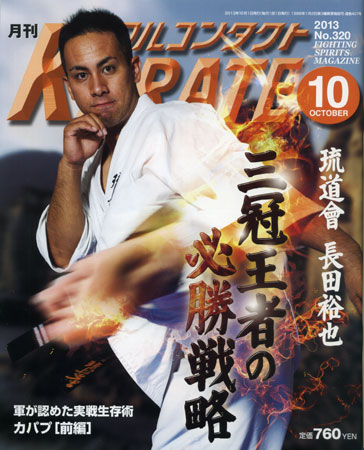





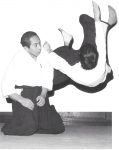
Leave a Reply